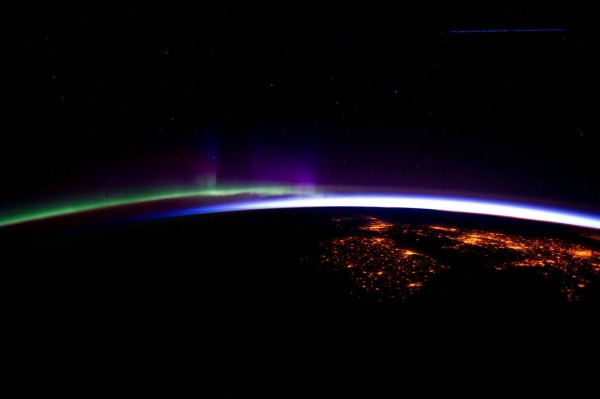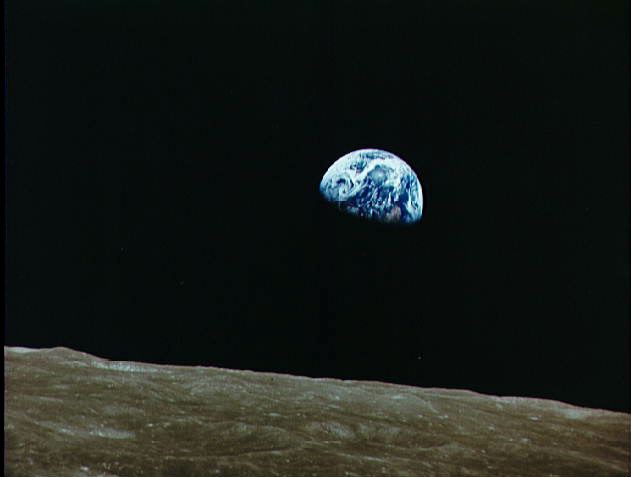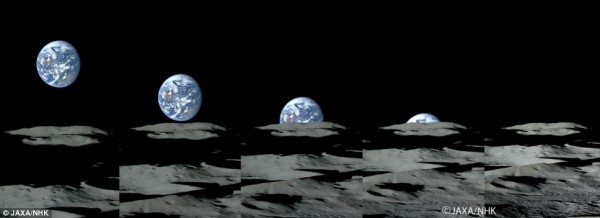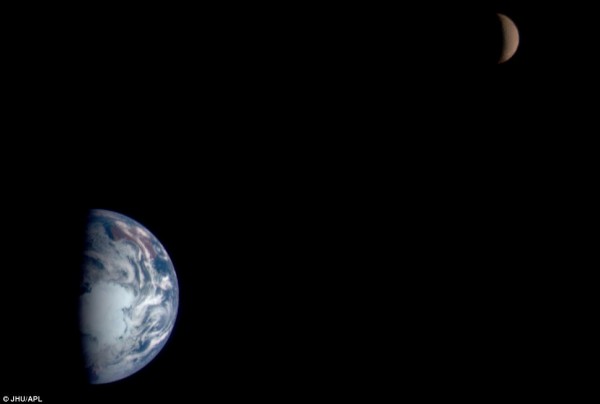Venus, Earth, and Mars on November 18, 2020, as seen via the NASA-ESA Solar Orbiter (SolO). This image was captured from about 155.7 million miles (250.6 million km) away. That’s in contrast to our sun’s distance from Earth of about 93 million miles (150 million km). In this image, the sun is located on the right, outside the image frame. Image via ESA/ NASA/ NRL/ Solar Orbiter/ SolOHI.
How does Earth look from space? And … how far away from Earth can we be and see it still with our own eyes?
To find the answer to these questions, let’s take an imaginary trip through the solar system. Spacecraft exploring our solar system have given us marvelous views of Earth. Keep reading, and check out the photos on this page, to see how Earth looks from various other places in our own neighborhood of space.
First, imagine blasting off and being about 200 miles (300 km) above Earth’s surface. That’s about the height of the orbit of the International Space Station (ISS). From the window of the ISS, the surface of the Earth looms large. In the daytime, you can clearly see major landforms. At night, from Earth orbit, you see the lights of Earth’s cities.

Earth in daylight, from the International Space Station in 2012. The North American Great Lakes shine in the sun. Read more about this image.

Earth at night, from the ISS in 2012. Ireland is in the foreground, and the United Kingdom in the back and to the right. A bright sunrise is in the background. Greens and purples show an aurora borealis along the rest of the horizon.
Let’s get farther away, say, the distance of the orbit of the moon.
As we pass the moon – some quarter million miles (about 380,000 km) away – Earth looks like a bright ball in space. It’s not terribly different from the way the moon looks to us.
EarthSky lunar calendars show the moon phase for every day in 2021. We’re guaranteed to sell out. Get one while you can!
The first images of the Earth from the moon came from the Apollo mission. Apollo 8 in 1968 was the first human spaceflight to leave Earth orbit. It was the first earthly spacecraft to be captured by and escape from the gravitational field of another celestial body, in this case the moon.
It was the first voyage in which humans visited another world and returned to return to Earth.

Earth seen from moon via Apollo 8 astronauts in 1968. Image via NASA.
In the decades since Voyager first began traveling outward, moon exploration has become more common. The robotic Kaguya spacecraft orbited around Earth’s moon in 2007. Launched by Japan, and officially named the Selenological and Engineering Explorer (SELENE), Kaguya studied the origin and evolution of the moon. The frame below is from Kaguya’s onboard HDTV camera.

Earth viewed from the moon by Kaguya in 2007. Image via SELENE Team JAXA/ NHK.

Another image from Kaguya, which got footage and stills of Earth setting. Remember that, if you were on the moon, you would not see Earth rise or set. But spacecraft in orbit around the moon do experience this scene. Image via JAXA.
Now let’s keep moving outward until we can see both the Earth and moon together in space. The next picture was mind-blowing when first released. It shows a crescent-shaped Earth and moon – the first of its kind ever taken by a spacecraft – on September 18, 1977.

This picture of a crescent-shaped Earth and moon – 1st of its kind ever taken by a spacecraft – was recorded September 18, 1977, by Voyager 1 at a distance of 7.25 million miles (11.66 million km) from Earth. The moon is at the top of the picture and beyond the Earth as viewed by Voyager. Image via NASA.
Since 1977, many robot spacecraft have ventured outward into our solar system. The mosaic below shows images of Earth and the moon acquired by the multispectral imager on the Near Earth Asteroid Rendezvous Spacecraft (NEAR) on January 23, 1998, 19 hours after the spacecraft swung by Earth on its way to the asteroid 433 Eros. The images of both were taken from a range of 250,000 miles (400,000 km), approximately the same as the distance between the two bodies.

Earth and moon seen by NEAR spacecraft in 1998.
Speeding outward from the Earth and moon system, you pass the orbits of the planets Mars, Jupiter and Saturn. From all of these worlds, Earth looks like a star, which gets fainter as you get farther away.

Earth and moon, as seen from Mars by NASA’s Curiosity rover on January 31, 2014. Read more about this image.

View larger. | Earth seen behind the rings of Saturn. See us in the lower right? Mars and Venus are in the upper left. Image via the Cassini spacecraft, July 19, 2013.

This is the famous image known as Pale Blue Dot. It’s a photograph of Earth taken on February 14, 1990, by the Voyager 1 space probe from a record distance of about 6 billion kilometers (3.7 billion miles). Earth is the bluish-white speck approximately halfway down the brown band to the right.
The images above are from Saturn, the sixth planet outward in orbit around the sun. I’ve never seen any image of Earth from Uranus or Neptune or any other body beyond Saturn’s orbit. Only five spacecraft from Earth – the two Voyager spacecraft, the two Pioneers, and the New Horizons spacecraft, which passed Pluto in 2015 – have ever ventured that far. Those craft weren’t designed to look back at Earth, and, to my knowledge, they didn’t capture images of Earth from distances beyond Saturn.
But, speaking theoretically now, could Earth be seen from distances beyond Saturn?
Speaking only in terms of Earth’s brightness, the answer is yes. Our world doesn’t become too faint to see with the eye alone until far beyond Neptune’s orbit, at around 9 billion miles (14 billion km) from home. Now consider Pluto’s orbit. It’s highly elliptical, stretching from just 2.7 billion miles (4.4 billion km) to over 4.5 billion miles (7.3 billion km) from the sun. Pluto is within the limiting distance at which – if we just consider brightness alone, no other factors – we should be able to see Earth with the eye alone.
But there is another factor. As you go outward from Earth, our world appears closer and closer to the blazing sun. As you get farther away, the sun’s glare begins to overwhelm the view of Earth. From Pluto – even though Earth would be bright enough to see – you probably couldn’t see it in the sun’s glare.
So that is the answer to the question of how far you could be from Earth, and still see it with your own eyes. Although no one knows for sure because no one has tried it (and because human eyesight varies from person to person), the Earth would become impossible to see with the eye somewhere beyond Saturn’s orbit.
Now let’s change the game. Let’s say we could use instruments, and not just the eye alone. Suppose intrepid astronaut-astronomers went to Pluto. Suppose they took all the instruments they needed to view Earth in the sun’s glare. Could they use telescopes, obscuring disks, and other techniques to get a glimpse of Earth? Maybe!
But it still wouldn’t be easy.
Read more: Wikipedia has a long write-up on extraterrestrial skies
Bottom line: How does Earth look from space? How far away in space could you view Earth with the eye alone? Considering only brightness, the answer is about 9 billion miles (14 billion km) away, about the distance of Neptune or Pluto. In practice, though, seeing it from that distance would be a challenge because the sun’s glare would overwhelm the view of Earth.
